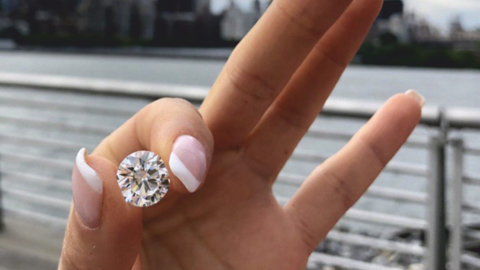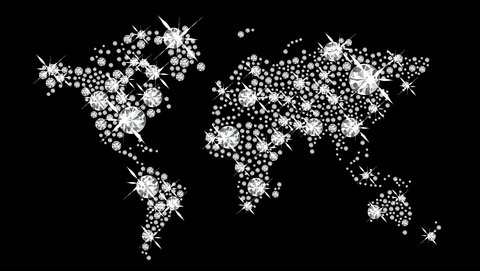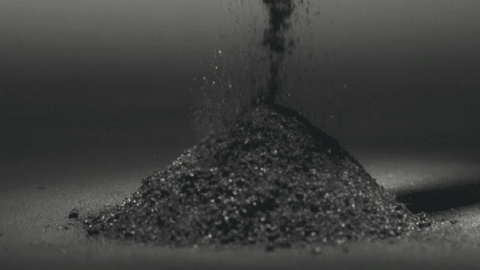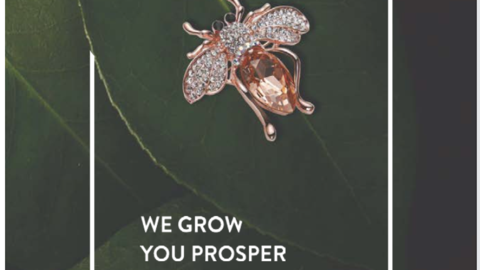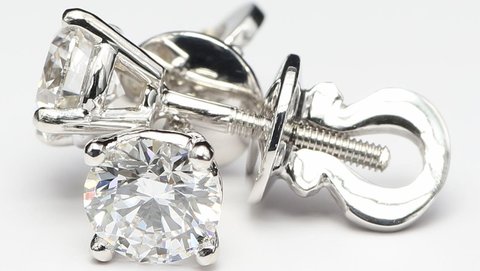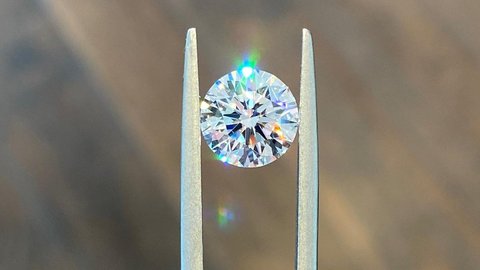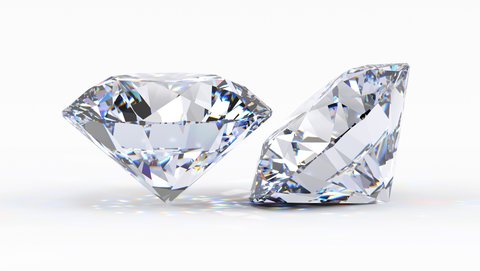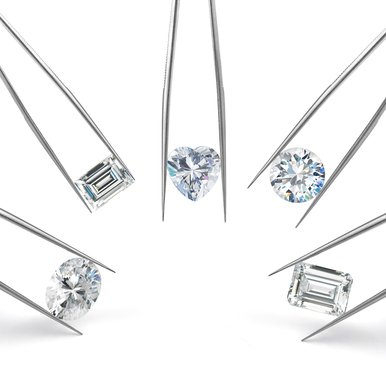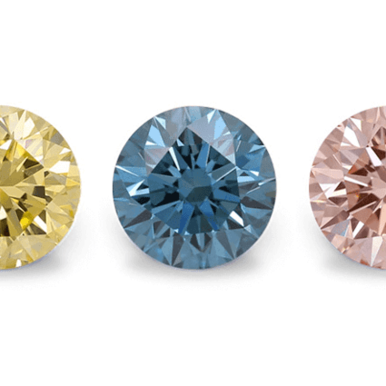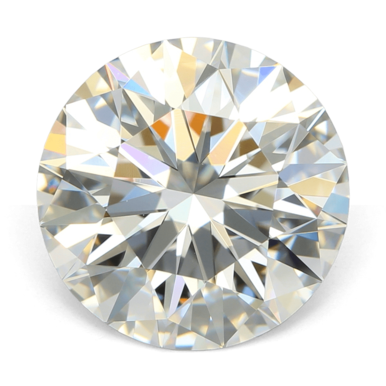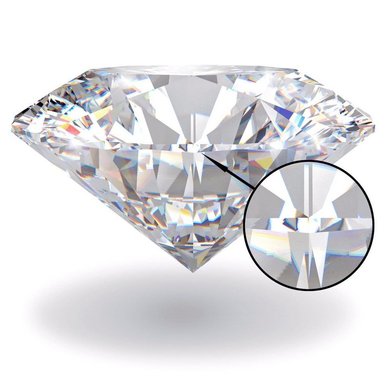
Diamond Clarity Essentials: Understanding Value, Grading & Lab-Grown Excellence
Are you considering a lab-grown diamond purchase but feeling overwhelmed by terms like "VS1" or "inclusion"? Diamond clarity is one of the crucial factors that determines both the beauty and value of your investment. At Labrilliante, we specialize in exceptional lab-grown diamonds that offer both ethical sourcing and outstanding clarity characteristics.
Lab-grown diamonds present a revolutionary opportunity to obtain stones with excellent clarity at more accessible price points. These diamonds display the same physical, chemical, and optical properties as mined diamonds but are created in controlled laboratory environments that can minimize certain types of inclusions.
When evaluating a diamond's clarity, gemologists assess the presence, size, nature, and location of internal characteristics (inclusions) and external features (blemishes). For lab-grown diamonds, understanding clarity becomes particularly important as it helps you maximize value while ensuring your stone exhibits the brilliant sparkle you desire.
Whether you're searching for the perfect engagement ring or a stunning pair of earrings, clarity impacts not only your diamond's appearance but also its durability and investment value. Let's explore the fascinating world of diamond clarity with a special focus on how lab-grown diamonds are revolutionizing clarity standards.

Understanding the Diamond Clarity Scale: From Flawless to Included
When shopping for lab-grown diamonds, understanding the clarity scale is essential for making an informed decision. The Gemological Institute of America (GIA) has established a standardized grading system that applies to both mined and lab-grown diamonds, ranging from Flawless (FL) to Included (I3).
What Does Each Clarity Grade Mean for Lab-Grown Diamonds?
Flawless (FL) & Internally Flawless (IF): These exceptional lab-grown diamonds have no inclusions visible under 10x magnification. IF diamonds may have minor surface blemishes. Only about 2% of lab-grown diamonds achieve these prestigious grades, making them both rare and valuable.
Very, Very Slightly Included (VVS1 & VVS2): These lab-grown diamonds contain minuscule inclusions that are extremely difficult for even skilled gemologists to locate under 10x magnification. The precision of the lab-growing process often results in a higher percentage of VVS diamonds compared to mined stones.
Very Slightly Included (VS1 & VS2): Minor inclusions are visible under magnification but remain typically invisible to the naked eye. VS clarity lab-grown diamonds offer exceptional value as they appear visually perfect while costing significantly less than higher grades.
Slightly Included (SI1 & SI2): Small inclusions are visible under magnification and may be visible to the naked eye in some cases. Lab-grown SI diamonds often appear cleaner than their mined counterparts due to the controlled growth environment.
Included (I1, I2 & I3): These diamonds have inclusions visible to the naked eye that may affect brilliance and durability. Even at these grades, lab-grown diamonds tend to have more uniform inclusion patterns than mined diamonds.

Clarity Grade Comparison for Lab-Grown Diamonds
| Clarity Grade | Visibility to Naked Eye | Common Inclusions in Lab-Grown | Price Premium | Recommended for |
|---|---|---|---|---|
| FL/IF Flawless/Internally Flawless | Perfectly clean | None visible | +40-50% over VS | Investment pieces |
| VVS1-VVS2 Very Very Slightly Included | Virtually invisible | Tiny pinpoints, minute growth lines | +20-30% over VS | Significant jewelry pieces |
| VS1-VS2 Very Slightly Included | Invisible to naked eye | Minuscule crystals, feathers | Baseline value | Engagement rings, significant jewelry |
| SI1 Slightly Included 1 | Usually invisible | Small crystals, clouds | -20-30% from VS | All jewelry types |
| SI2 Slightly Included 2 | Sometimes visible | Noticeable crystals, clouds, feathers | -40-50% from VS | Side stones, smaller jewelry |
| I1-I3 Included | Visible inclusions | Large inclusions affecting brilliance | -60-80% from VS | Industrial use, inexpensive jewelry |
What Does VS1 Clarity Mean in a Lab-Grown Diamond?
VS1 (Very Slightly Included 1) clarity is often considered the sweet spot for lab-grown diamonds. These stones contain minor inclusions that are difficult to see under 10x magnification and impossible to detect with the naked eye. Because lab-grown diamonds are created in controlled environments, VS1 lab-grown diamonds frequently have fewer and more evenly distributed inclusions than their mined counterparts, resulting in exceptional sparkle and brilliance.
At Labrilliante, our VS1 lab-grown diamonds offer incredible value, providing visually flawless appearance without the premium price of higher clarity grades. This makes them an ideal choice for engagement rings and other significant jewelry pieces where beauty and budget considerations are equally important.
Types of Inclusions & Their Impact on Lab-Grown Diamonds
While lab-grown diamonds form in controlled environments, they still develop characteristic inclusions during the growth process. Understanding these inclusions can help you make an informed decision when purchasing a lab-grown diamond from Labrilliante.
Common Inclusions in Lab-Grown Diamonds
Metallic Inclusions: Unique to lab-grown diamonds, these tiny metal particles from the growth catalyst can appear as small pinpoints or dark spots. CVD-grown diamonds typically have fewer of these compared to HPHT-grown diamonds.
Crystal Inclusions: Small crystals of diamond or other minerals that formed during the growth process. In lab-grown diamonds, these tend to be more symmetrically distributed than in natural diamonds.
Growth Lines: These appear as faint lines marking distinct growth phases during formation. They're more common in CVD-grown diamonds and are often arranged in patterns.
Clouds: Clusters of microscopic inclusions that can appear as hazy areas. Lab-grown diamonds often have fewer and smaller clouds than natural diamonds.
Feathers: Small fractures within the diamond. Lab processes can minimize these structurally significant inclusions, resulting in potentially stronger stones.
Needles: Thin, elongated crystal inclusions. These are less common in lab-grown diamonds due to the controlled growth environment.
How Inclusions Affect Resale Value of Lab-Grown Diamonds
According to industry data, clarity has a significant impact on diamond resale value:
- Lab-grown diamonds with FL-VVS clarity retain approximately 60-65% of their purchase value, compared to 45-50% for natural diamonds of the same clarity.
- VS clarity lab-grown diamonds typically retain 50-55% of their purchase value.
- SI clarity lab-grown diamonds retain 40-45% of their value.
This retention value is heavily influenced by inclusion characteristics:
- Visibility: Invisible inclusions (even under magnification) preserve value better.
- Location: Inclusions away from the table impact value less.
- Type: Metallic inclusions unique to lab-grown diamonds can sometimes create distinctive patterns that collectors value.
Practical Tip from Labrilliante Experts
When selecting a lab-grown diamond, request an inclusion plot or clarity photograph. This will show you exactly where inclusions are located and help you determine if they'll be visible once the diamond is set. Remember that inclusions on the pavilion (bottom) side will be largely hidden once the diamond is mounted in jewelry.

Clarity Enhancement Methods for Lab-Grown Diamonds
While lab-grown diamonds naturally tend to have fewer inclusions than mined diamonds, clarity enhancement techniques can further improve their appearance. At Labrilliante, we believe in complete transparency about enhancement methods, ensuring you understand exactly what you're purchasing.
Common Clarity Enhancement Techniques
Laser Drilling: This precision technique uses focused laser beams to create microscopic tunnels to reach dark inclusions. Once reached, these inclusions can be bleached or dissolved, resulting in a more transparent stone. For lab-grown diamonds, this technique is less frequently needed but can be particularly effective for removing isolated dark metallic inclusions.
Clarity Enhancement Methods for Lab-Grown Diamonds
| Enhancement Aspect | Impact on Lab-Grown Diamonds | Permanence | Disclosure Requirements |
|---|---|---|---|
| Laser Drilling Precision technique | Creates microscopic channels to remove dark inclusions | Permanent | Must be disclosed by ethical retailers |
| Fracture Filling Glass-like filling | Fills microscopic feathers with glass-like material | Semi-permanent (can deteriorate with heat) | Always requires disclosure |
| HPHT Treatment Post-growth process | Re-creates growth conditions to dissolve certain inclusions | Permanent | Requires disclosure but doesn't impact durability |
| Deep Boiling Chemical process | Removes surface-reaching inclusions through chemical cleaning | Permanent for stable inclusions | Generally disclosed as "clarity enhanced" |
Fracture Filling: This process introduces a glass-like substance into feather inclusions, making them less visible by closely matching the diamond's refractive index. While effective, this enhancement requires special care, as the filling material can deteriorate with heat exposure during jewelry repairs.
HPHT Post-Growth Treatment: High Pressure-High Temperature treatment can dissolve certain types of inclusions in lab-grown diamonds. This process essentially recreates growth conditions to allow for internal restructuring, particularly effective for lab-grown diamonds with cloud-type inclusions.
Deep Boiling: A specialized cleaning process using strong acids that can dissolve surface-reaching inclusions. This method is only effective for specific inclusion types and is less commonly used for lab-grown diamonds.

Enhanced vs. Non-Enhanced Lab-Grown Diamonds: What to Consider
Durability Concerns: The most common question about enhanced diamonds is whether they're less durable. For lab-grown diamonds:
- Laser-drilled stones remain structurally sound, though the tiny tunnels create potential weak points under extreme pressure.
- Fracture-filled stones require special care during cleaning and repairs, as the filling material can deteriorate at temperatures above 600°C.
- HPHT-treated lab-grown diamonds show no significant reduction in durability compared to untreated stones.
Certification and Disclosure: All enhanced lab-grown diamonds at Labrilliante come with detailed certification noting the specific enhancement methods used. According to GIA standards, enhancements must be disclosed at every point of sale. Always request clarity enhancement information when comparing prices between retailers.
Value Considerations: Enhanced lab-grown diamonds typically cost 20-40% less than non-enhanced diamonds of similar apparent clarity. However, their resale value may be proportionally lower, making them better suited for jewelry you plan to keep rather than as investment pieces.
The Labrilliante Commitment to Transparency
At Labrilliante, we provide:
- Detailed documentation of any enhancement methods used
- Microscopic images showing before and after results when applicable
- Specific care instructions for enhanced stones
- Competitive pricing that accurately reflects the enhancement status

Pros and Cons of Clarity-Enhanced Lab-Grown Diamonds
When considering a lab-grown diamond purchase, understanding the advantages and limitations of clarity-enhanced stones can help you make the right decision for your specific needs and preferences.
Advantages of Clarity-Enhanced Lab-Grown Diamonds
Significant Cost Savings: Perhaps the most compelling benefit is affordability. A clarity-enhanced lab-grown diamond can appear equivalent to a higher clarity grade at a fraction of the cost. For example:
- An enhanced SI2 lab-grown diamond can look similar to a non-enhanced VS2, at 30-40% lower cost
- A 1-carat enhanced VS2 lab-grown diamond may retail for $1,600-2,200, while a non-enhanced VS1 of similar appearance might cost $2,800-3,500
Larger Carat Weight Possibilities: The budget you've allocated for a 1-carat VS clarity lab-grown diamond might instead afford you a 1.5-carat enhanced stone with similar apparent clarity.
Environmental Considerations: Enhancing existing lab-grown diamonds rather than growing new higher-clarity stones can reduce overall energy consumption in the production process.
Excellent Visual Appeal: For diamonds intended primarily for aesthetic purposes rather than investment, enhanced stones offer exceptional brilliance and fire at more accessible price points.
Limitations to Consider
Restricted Heat Exposure: Particularly for fracture-filled diamonds, exposure to high temperatures during jewelry repairs can damage the enhancement material, potentially requiring re-treatment.
Resale Value Implications: Enhanced lab-grown diamonds typically experience a steeper depreciation curve compared to non-enhanced stones, retaining approximately 15-25% less value over time.
Special Care Requirements: Some enhanced stones require specific cleaning protocols, avoiding ultrasonic cleaners or steam cleaning methods that could compromise the enhancement.
Insurance Considerations: Some insurance providers charge higher premiums or have special provisions for clarity-enhanced stones, potentially offsetting some of the initial savings.
Transparency in the Marketplace: Do Retailers Disclose Enhancements?
While industry organizations like the GIA and FTC require disclosure of enhancements, compliance varies among retailers. At Labrilliante, we uphold the highest ethical standards by:
- Clearly marking all enhanced lab-grown diamonds in our inventory
- Providing detailed enhancement documentation with every purchase
- Training our consultants to explain the practical implications of each enhancement type
- Never representing enhanced stones as equivalent to naturally higher clarity diamonds
Who Should Consider Clarity-Enhanced Lab-Grown Diamonds?
Enhanced lab-grown diamonds are particularly suitable for:
- Budget-conscious shoppers prioritizing visual impact
- Fashion jewelry that will be worn occasionally rather than daily
- Secondary stones in multi-stone settings
- Consumers with near-term jewelry needs rather than long-term investment goals
Common Inclusions in Lab-Grown Diamonds: A Visual Guide
At Labrilliante, we believe in complete transparency about our diamonds' characteristics. While our lab-grown diamonds offer exceptional clarity, each stone has its own unique identity. Understanding the different types of inclusions helps you make an informed decision when selecting your perfect diamond.
Common Inclusions in Lab-Grown Diamonds: A Visual Guide
| Inclusion Type | Description | Typical Appearance | Impact on Clarity | Common in |
|---|---|---|---|---|
| Graining | Internal growth lines that appear as faint lines or reflections | Subtle waves or lines visible when tilted | Minimal impact; usually only affects FL/IF grades | Both lab and natural diamonds |
| Feather | Small fractures within the diamond | Transparent, feather-like appearance | Varies widely depending on size and location; can impact durability if large | More common in natural diamonds |
| Cavity | Small opening on the surface that extends into the diamond | Irregular depression or hollow | Moderate to significant depending on size; affects polish | Both lab and natural diamonds |
| Bearding | Fine, hair-like lines radiating from the girdle | Fuzzy appearance around the diamond's edge | Minor impact unless extensive | More common in poorly cut diamonds |
| Cloud | Cluster of tiny, closely grouped inclusions | Hazy or foggy area in the diamond | Can significantly impact brilliance if large or dense | Common in CVD lab diamonds |
| Crystal | Mineral crystals trapped within the diamond | Small, geometric shapes inside the diamond | Varies based on color, size, and location | HPHT lab diamonds (often metallic) |
| Pinpoint | Extremely small crystals that appear as dots | Tiny dots visible only under magnification | Minor impact unless clustered in clouds | Common in lab-grown diamonds |
| Needle | Long, thin crystal inclusions | Slender, rod-like formations | Usually minimal impact unless large or numerous | More common in CVD lab diamonds |
Maintaining Your Brilliance: Care Guide for Lab-Grown Diamonds
Whether you've chosen a natural or clarity-enhanced lab-grown diamond, proper care ensures your stone maintains its brilliance for generations. However, enhanced diamonds require specific maintenance considerations that Labrilliante wants you to understand fully.
Specialized Care for Clarity-Enhanced Lab-Grown Diamonds
Fracture-Filled Diamonds: These require the most careful handling due to the presence of glass-like filling material.
- Heat Sensitivity: Avoid exposure to temperatures above 600°F (315°C). Alert jewelers about enhancement before repairs, especially those involving torches or soldering.
- Chemical Sensitivity: Avoid harsh cleaning chemicals like chlorine bleach or acetone, which can deteriorate the filling material over time.
- Ultrasonic Warning: Never use ultrasonic cleaners, as the vibrations can widen filled fractures and potentially dislodge the filling material.
Laser-Drilled Diamonds: While more stable than fracture-filled stones, they still benefit from gentle treatment.
- Cleaning Considerations: The microscopic drill channels can potentially trap dirt or cleaning solutions, requiring thorough but gentle rinsing.
- Structural Integrity: Though rare, extreme pressure on drilled areas should be avoided to prevent potential expansion of drill channels.
HPHT-Treated Lab-Grown Diamonds: These enhanced diamonds are among the most stable and require no special care beyond standard diamond maintenance.

Safe Cleaning Methods for Lab-Grown Diamonds
| Cleaning Method | Natural Lab-Grown | Laser-Drilled | Fracture-Filled | HPHT-Treated |
|---|---|---|---|---|
| Mild Soap Solution Gentle daily cleaning | ✓ Safe | ✓ Safe | ✓ Safe | ✓ Safe |
| Jewelry Cleaning Solution Commercial products | ✓ Safe | ✓ Safe | ⚠️ Check ingredients | ✓ Safe |
| Ultrasonic Cleaner Vibration-based | ✓ Safe | ⚠️ Use with caution | ❌ Avoid | ✓ Safe |
| Steam Cleaning High-temperature | ✓ Safe | ✓ Safe | ❌ Avoid | ✓ Safe |
| Ammonia Solution Deep cleaning | ✓ Safe | ✓ Safe | ❌ Avoid | ✓ Safe |
| Professional Cleaning Jeweler service | ✓ Recommended | ✓ Disclose enhancement | ✓ Disclose enhancement | ✓ Disclose enhancement |
Recommended Cleaning Routine for All Lab-Grown Diamonds
For optimal results regardless of enhancement status:
- Prepare a solution of warm water and mild dish soap
- Soak the diamond jewelry for 20-30 minutes
- Gently brush with a soft toothbrush, paying attention to the underside of the setting
- Rinse thoroughly in warm water
- Pat dry with a lint-free cloth or allow to air dry
Insurance Considerations for Enhanced Lab-Grown Diamonds
Protecting your investment through proper insurance is particularly important for enhanced stones:
- Full Disclosure: When insuring enhanced lab-grown diamonds, declare all enhancement methods to ensure proper coverage in case of damage.
- Documentation: Keep all enhancement documentation and certification from Labrilliante with your insurance policy.
- Specialized Riders: Some insurance companies offer specific coverage for enhanced stones that includes re-treatment if enhancement is damaged.
- Valuation Accuracy: Enhanced lab-grown diamonds should be appraised based on their enhanced status, not compared to natural stones of similar appearance.
At Labrilliante, we recommend annual professional inspections for all enhanced lab-grown diamonds to ensure the integrity of any treatments and to maintain your warranty coverage. Our inspection service helps identify any potential issues early.
Read more about Diamond 101
Frequently Asked Questions About Lab-Grown Diamond Clarity
Clarity-enhanced lab-grown diamonds are genuine diamonds with identical chemical composition (pure carbon) to natural diamonds. Enhancement processes like laser drilling or fracture filling modify existing inclusions without changing the diamond's fundamental structure. These treatments must be disclosed by reputable retailers like Labrilliante, but the stone itself remains a true diamond with the same optical and physical properties.
No, enhanced lab-grown diamonds cannot pass certification as natural diamonds. Advanced testing equipment used by reputable gemological laboratories can identify both laboratory origin and enhancement methods. The growth structure of lab-grown diamonds creates distinctive patterns visible under specialized imaging, while enhancement treatments leave detectable signatures. Attempting to misrepresent an enhanced lab-grown diamond as natural constitutes fraud and violates FTC regulations.
Certain clarity enhancements may change over time, particularly fracture filling. The glass-like filling material can deteriorate with exposure to high heat (jewelry repairs), harsh chemicals, or ultrasonic cleaning. Laser-drilled diamonds remain stable, though the channels can trap dirt. HPHT clarity treatment is permanent and stable. This variability is why Labrilliante provides specific care instructions with each enhanced diamond and offers re-treatment options if needed.
The location of inclusions often matters more than their quantity. Lab-grown diamonds with inclusions positioned near the girdle (edge) or pavilion (bottom) receive better clarity grades than those with similar inclusions under the table (top face). Additionally, colorless inclusions impact grades less than dark or reflective ones. The controlled lab environment can sometimes place inclusions in less visible locations, resulting in better clarity grades despite similar total inclusion volume.
Most insurance claims for lost diamonds rely on documentation rather than examination of the missing stone. This is why Labrilliante provides detailed certification indicating enhancement status—it ensures proper valuation for insurance purposes. Without proper documentation, replacement value might default to non-enhanced stones of similar appearance. Some specialized jewelry insurance providers now offer specific clauses for enhanced lab-grown diamonds, recognizing their unique value proposition in the market.
Always inform your jeweler that your diamond is clarity-enhanced before any repair work. For fracture-filled stones, traditional high-heat soldering techniques can damage the enhancement material, requiring re-treatment. Many Labrilliante partner jewelers use alternative techniques like laser welding for enhanced diamonds. We provide complementary assessment services before repair work and can recommend qualified jewelers who specialize in working with enhanced stones if needed.
Clarity enhancement can dramatically improve a diamond's appearance - typically by 2-3 clarity grades visually. For example, an enhanced I1 lab-grown diamond might appear similar to an SI1, while an enhanced SI2 can look comparable to a VS2. The most significant improvements occur with darker inclusions, as treatments like laser drilling and fracture filling specifically target these visible flaws. At Labrilliante, we provide before-and-after documentation showing the exact visual improvement for each enhanced stone.
Quality clarity enhancements actually improve a diamond's light performance by eliminating light-blocking inclusions. Laser drilling creates microscopic channels too small to affect light return, while properly executed fracture filling uses material with a refractive index closely matching diamond. In fact, photometric testing shows enhanced diamonds can gain 5-15% improved light return after treatment. However, poor-quality enhancements from inexperienced processors may create a cloudy appearance - which is why Labrilliante partners exclusively with certified enhancement specialists.


